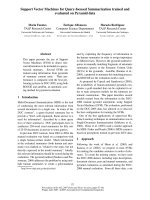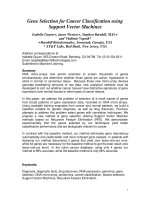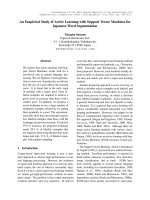Bài 6 Slide Support Vector Machines Kernels
Bạn đang xem bản rút gọn của tài liệu. Xem và tải ngay bản đầy đủ của tài liệu tại đây (1.64 MB, 68 trang )
Support Vector Machines
& Kernels
Doing really well with linear decision surfaces
Outline
Prediction
Why might predictions be wrong?
Support vector machines
Doing really well with linear models
Kernels
Making the non-‐linear linear
Why Might Predictions be Wrong?
•
True non-‐determinism
–
–
–
–
Flip a biased coin
p(heads) = θ
Estimate θ
If θ > 0.5 predict ‘heads’, else ‘tails’
Lots of ML research on problems like this:
–
–
Learn a model
Do the best you can in expectation
Why Might Predictions be Wrong?
•
Partial observability
–
–
Something needed to predict y is missing from observation x
N-‐bit parity problem
• x contains N-‐1 bits (hard PO)
• x contains N bits but learner ignores some of them (sof PO)
•
Noise in the observation x
–
–
Measurement error
Instrument limitations
Why Might Predictions be Wrong?
•
•
True non-‐determinism
Partial observability
– hard, sof
•
•
•
Representational bias
Algorithmic bias
Bounded resources
Representational Bias
•
Having the right features (x) is crucial
0
x
x2
Support Vector
Machines
Doing Really Well with Linear Decision Surfaces
Strengths of SVMs
•
Good generalization
–
–
•
•
•
•
in theory
in practice
Works well with few training instances
Find globally best model
Efficient algorithms
Amenable to the kernel trick
Minor Notation Change
To better match notation used in SVMs
...and to make matrix formulas simpler
We will drop using superscripts for the i th instance
i th instance
i th instance label
j th feature of i th instance
x (i)
y (i)
(i)
xj
Bold denotes vector
x
i
yi
x
Non-‐bold
denotes scalar
ij
9
Linear Separators
•
Training instances
x 2R
d+1
, x0 = 1
y 2 {—1, 1}
•
Model parameters
✓
•
Recall:
R
Inner (dot) product:
|
hu, vi = u · v = u v
X
d+1
Hyperplane
=
|
✓ x = h✓, x i = 0
•
u iv
i
Decision function
|
h (x ) = sign(✓ x ) = sign(h✓, x i )
i
Intuitions
Intuitions
Intuitions
Intuitions
A “Good” Separator
Noise in the Observations
Ruling Out Some Separators
Lots of Noise
Only One Separator Remains
Maximizing the Margin
“Fat” Separators
“Fat” Separators
margin
Why Maximize Margin
Increasing margin reduces capacity
•
i.e., fewer possible models
Lesson from Learning Theory:
•
If the following holds:
–
–
H is sufficiently constrained in size
and/or the size of the training data set n is large,
then low training error is likely to be evidence of low generalization error
23
Alternative View of Logistic Regression
1
h✓
(x) =
h ✓ (x ) = g(z)
1 + e— ✓T x
T
z= ✓ x
If y
= 1
, we want
h ✓ (x ) ⇡ 1 ,
If y = 0 , we want h✓ (x) ⇡ 0 ,
X
✓T
x
T
✓ x
0
0
n
J (✓) = —
✓(x i ))]
[y log
h (x ✓
) + (1
i
i — y ) log (1 —
i h
i=1
min J (✓)
✓
Based on slide by Andrew Ng
|
cost1(✓ xi)
|
cost0(✓ xi)
24
Alternate View of Logistic Regression
Cost of example:
—yi log h✓ (x i ) — (1 — y i ) log (1 — h✓ (x i ))
1
h✓
(x) =
T
z= ✓ x
1 + e — ✓T x
If
y= 1
Based on slide by Andrew Ng
T
(want ✓ x
0 ):
T
If y = 0 (want ✓ x
0 ):
25









